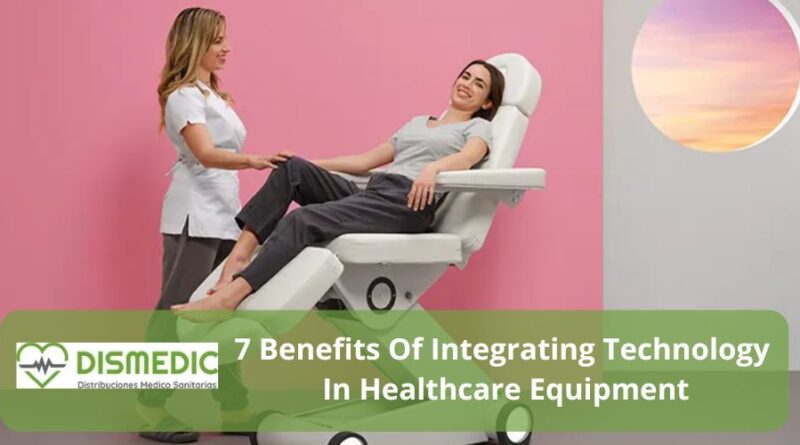7 Benefits Of Integrating Technology In Healthcare Equipment
In today’s world, technology is everywhere, and it’s not just limited to our smartphones and computers. It’s also making a big impact in the field of healthcare, especially in the equipment used to diagnose, treat, and monitor patients.
Integrating technology into healthcare equipment means using advanced gadgets and tools to help doctors and nurses take care of patients better. Imagine a smart thermometer that not only tells your temperature but also sends that information directly to your doctor’s computer. Or a special bed that can adjust itself to keep patients comfortable and prevent bedsores. With the help of technology and the internet, you can buy medical stretchers online.
These technological upgrades make healthcare more efficient and accurate. For example, a machine called an MRI scanner uses powerful magnets and computers to take detailed pictures inside your body, helping doctors diagnose diseases more accurately.
Another cool example is telemedicine, where you can talk to a doctor through video calls without even leaving your home. This is super handy, especially for people who live far away from hospitals or have trouble traveling.
By blending technology with healthcare equipment, we can provide better care for patients, make medical procedures safer, and even save lives. It’s like giving our healthcare system a high-tech upgrade!
Let’s Explore Seven key Benefits Of Integrating Technology Into Healthcare Equipment.
Improved Accuracy And Precision
One of the most significant advantages of using technology in healthcare equipment is the improvement in accuracy and precision. Advanced technologies such as AI (Artificial Intelligence) and machine learning algorithms can analyze vast amounts of data quickly and accurately, helping healthcare professionals make more informed decisions. For example, diagnostic imaging equipment like MRI machines can provide detailed images of the body’s internal structures, helping doctors detect diseases and conditions with greater accuracy than ever before. You can also buy Pozzi pliers online in your budget without going or roaming here and there.
Faster Diagnosis And Treatment
Technology can also speed up the diagnosis and treatment process, which is crucial, especially in emergency situations. With tools like telemedicine, doctors can remotely diagnose patients and prescribe treatment without the need for an in-person visit. Similarly, wearable devices and mobile health apps allow patients to monitor their health in real-time and alert healthcare providers to any changes or emergencies promptly.
Enhanced Patient Experience
Integrating technology into healthcare equipment can also improve the overall patient experience. For example, electronic medical records (EMRs) make it easier for healthcare providers to access and update patient information, reducing the need for paperwork and streamlining administrative tasks. Additionally, virtual reality (VR) technology can help patients manage pain and anxiety during medical procedures by immersing them in calming and distracting environments.
Remote Monitoring And Care
Technology enables remote monitoring and care, which is especially beneficial for patients with chronic conditions or those who live in remote areas. Devices like wearable fitness trackers and smart glucose monitors can continuously monitor vital signs and send data to healthcare providers in real-time, allowing for early intervention and personalized treatment plans. Remote monitoring also reduces the need for frequent hospital visits, saving patients time and money.
Cost Savings
Integrating technology into healthcare equipment can lead to significant cost savings for both healthcare providers and patients. For example, robotic surgery systems can perform complex procedures with greater precision and efficiency, reducing the need for lengthy hospital stays and post-operative care. Similarly, telemedicine appointments eliminate the need for travel expenses and time off work, making healthcare more accessible and affordable for everyone.
Improved Efficiency And Productivity
Technology streamlines healthcare processes and workflows, leading to improved efficiency and productivity. For instance, automated medication dispensing systems reduce the risk of medication errors and ensure patients receive the right dosage at the right time. Likewise, predictive analytics can help hospitals anticipate patient needs and allocate resources more effectively, reducing wait times and improving overall patient care.
Advancements In Research And Development:
Finally, integrating technology into healthcare equipment fosters advancements in research and development, leading to new treatments, therapies, and medical breakthroughs. For example, medical devices equipped with sensors and connectivity capabilities collect valuable data that researchers can use to better understand diseases and develop targeted interventions. Additionally, virtual reality simulations allow medical students to practice complex procedures in a safe and controlled environment, accelerating learning and innovation in the field of healthcare.
Conclusion
In conclusion, integrating technology into healthcare equipment offers numerous benefits, including improved accuracy and precision, faster diagnosis and treatment, enhanced patient experience, remote monitoring and care, cost savings, improved efficiency and productivity, and advancements in research and development. By harnessing the power of technology, we can revolutionize the way we deliver healthcare and ultimately improve patient outcomes and quality of life. Moreover, technology has made monitoring patients easier too. Devices like heart monitors can keep track of your heartbeat and alert doctors if something isn’t right.
In essence, technology in healthcare equipment is like having a team of superheroes working alongside doctors and nurses to provide better, faster, and safer care for patients.
Related Link: www.techybusinesses.com/the-benefits-of-choosing-dental-implants

